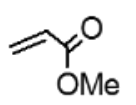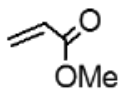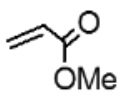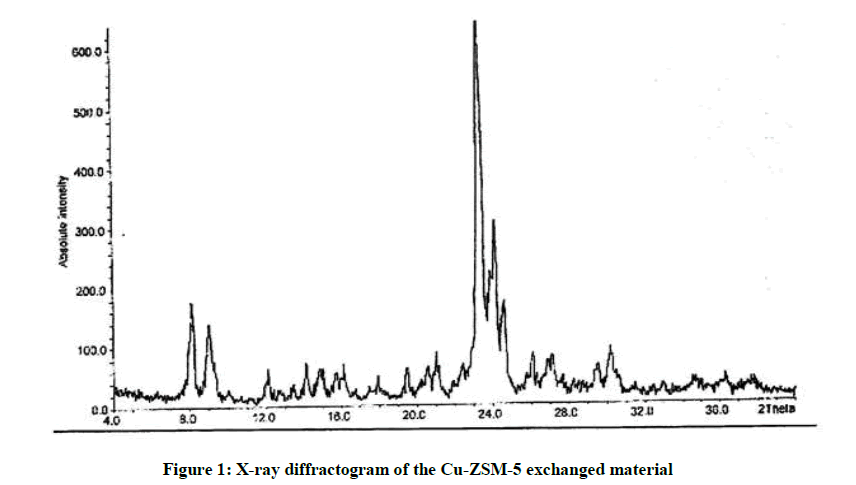Research Article - Der Pharma Chemica ( 2018) Volume 10, Issue 5
The Reaction of Aza Michael Catalyzed by Zeolite Cu-Zsm-5 under Solvent-Free Conditions
Elmeliani Mohammed1*, Djafri Fatiha1 and Djafri Ayada2
1Department of Chemistry, Faculty of Exact and Applied Sciences, Laboratory of Chemistry of Materials, Oran University, Ahmed Ben Bella, Algeria
2Department of Chemistry, Faculty of Exact and Applied Sciences, Applied Organic Synthesis Laboratory, Oran University, Ahmed ben Bella, Algeria
- *Corresponding Author:
- Elmeliani Mohammed
Department of Chemistry
Faculty of Exact and Applied Sciences
Laboratory of Chemistry of Materials
Oran University
Ahmed Ben Bella, Algeria
Abstract
The study is carried out to test the catalytic efficiency of Cu-ZSM-5 zeolite catalyst on the reaction of Aza Michael under solvent-free conditions, at room temperature this reaction is most exploited in organic chemistry, b-amino -esters, ketones, nitriles are useful for the preparation of several natural bioactive products, antibiotics, and chiral auxiliaries, through the use of the porous material catalyst (zeolite Cu-ZSM-5), and the reaction of Aza Michael addition a series of amines on α, β-unsaturated methyl acrylate, we have synthesized new cc or c-heteroatom products, these compounds is an attractive area of researchers in synthetic organic chemistry, and we have developed new synthesis methodologies for the preparation of these products. The reaction was carried out with favorable conditions: ambient temperature, and without solvent, that the products, which are synthesized, gave us a high yield, and excellent chemo selectivity.
Keywords
Aza-Michael, Zeolite Cu-ZSM-5, Amines, Alkenes, Environment, Synthesis
Introduction
Porous materials [1-5] are materials with a large number of cavities; this results in a large area per unit volume. These materials are metastable. Porous materials are classified into different categories, depending on the size of their porous; Micro porous materials [6,7] with pores less than 2 nm in size, macro porous solids with pore sizes greater than 50 nm, and intermediate grade are referred to as mesoporous materials [8,9]. Zeolites are natural materials (volcanic rock) or synthetic (three-dimensional assembly of tetrahedral units composed of 4 oxygen atoms at the center of which is positioned an aluminum or silicon atom. These crystallized and micro porous aluminosilicates are used in catalysis and to adsorb volatile organic compounds, these porous systems form excellent molecular sieves.
Zeolites [10-15] are one of the most important materials in chemistry, their application as catalysts being particularly important in relevant industrial processes. Indeed, the zeolites have been exploited as industrial catalysts in several petroleum-based chemical processes (Catalytic cracking, hydrocracking, isomerization, aromatics alkylation, methanol in gasoline, dewaxing, etc.) and in fine chemical processes (Selective oxidation of olefins or perfumes, synthesis, etc.). This great industrial applicability of zeolites can be linked to the exceptional versatility that these materials offer as solids whose structure and surface properties can be easily adapted. In this sense, zeolites [16-19] are micro porous materials with regular pores and cavities of molecular size (3-15 A) formed by heteroatoms in tetrahedral coordination (Primary Si and Al) linked by atomic atoms of oxygen.
The design and synthesis of a zeolite having the appropriate physicochemical properties for their application in an industrial chemical process must be rationalized taking into account not only the scientific requirements, but also the overall economic cost of its manufacture. In this sense, the direct synthesis or one pot of functional micro porous materials would offer interesting advantages over multi-step preparations, for example, significant savings that can be achieved by reducing the number of steps required to synthesize the micro porous material catalyst. Control over the variables that govern and direct the synthesis one-pot towards zeolites are stable at high temperatures and have a broad porous structure, which opens new perspectives for the treatment of large molecules especially in the field of petroleum refining and petrochemical catalysis processes.
The size of the particles is an important point in catalysis. The exchange surface should be as large as possible to improve the catalysis reaction [20-24]. The finer the particles, the more the specific surface increases. But a too fine size does not allow to capture the untreated molecules which inhibits the catalysis reaction.
The addition of Michael [25-29] or 1,4 addition is a synthesis tool for forming carbon-carbon bonds [30], but also carbon-nitrogen bonds named Aza-Michael, carbon-oxygen named Oxa-Michael and carbon-sulfur named Sulfa-Michael. This reaction, most often catalyzed by a base (or a phase transfer agent), requires two synthetic partners, a donor and a Michael acceptor.
The Michael addition reaction is a versatile synthetic methodology [31-47] for the efficient coupling of poor olefin electrons with a wide range of nucleophiles. This paper describes the role of the Michael addition reaction in intentional polymer synthesis for applications in emerging technologies, including biomedical, pharmaceutical, optoelectronic, composites, adhesives and polymer architectures, which are generally linear thermoplastics to hyper-branched polymers and networks, can be realized. The versatility of Michael's reaction, in terms of monomer selection, solvent and reaction temperature, allows the synthesis of sophisticated macromolecular structures under conditions where other reaction processes would not work. The utility of Michael addition in many biological applications, such as conjugated active principle polymers, is discussed in relation to the macromolecular structure. In addition to the Michael [48] reaction, a practical process has been developed for the addition of aliphatic or aromatic amines to alkenes by heterogeneous catalysis (acidic or basic), it is called the aza-Michael reaction, and can be carried out on large group activated alkenes such as esters, ketones, and β-unsaturated nitriles.
In general, the aza-Michael reaction requires particular conditions, such as short reaction time, very good chemo selectivity, high yield, ease of product purification, use of a catalyst, the inexpensive and reusable, are the main features of this protocol [49]. However, in some cases, the use of catalysts in stoichiometric amounts with substrates leads to side reactions. The use of heterogeneous catalysts offers several advantages such as Great stability, Easy handling, Recovery and reuse, Non-corrosive nature, long catalytic activity, respect the environment, Green protocol.
Michael's reaction and its modified form such as aza-Michael, thio-Michael and carba-Michael reaction is one of the most exploited reactions in organic chemistry. β-amino acids, esters, ketones, and nitriles are synthesized for the preparation of many nitrogen products, antibiotics and chiral auxiliaries. In addition, a large number of biologically active compounds contain parts of β-amino-ketone or ester. The development of new methodologies for the synthesis of such compounds is becoming attractive for research in synthetic organic chemistry. Although β-amino ketones can be prepared by the conventional Mannich reaction, it has several disadvantages, such as severe reaction conditions, longer reaction time, and the like.
A comparative study shows that the aza-Michael addition reaction leads to the formation of the c-c or c-heteroatom bond. From these results, we carried out a series of amine addition on α,β-unsaturated alkenes, active or not active in a dry medium catalyzed by zeolite Cu-ZSM-5.
Materials and Methods
The chemicals and solvents used in this work are products available at our Laboratory. We add in an Erlenmeyer Meyer (5 mmol, 1 eq) methyl acrylate on (6 mmol, 1.2 equivalent) amine and the mixture with stirring (0.100 mg) of CuZSM-5 at room temperature, and without solvent, followed the reaction by platelets CCM. The reaction is quenched, filtered and washed with dichloromethane, after which the solvent, excess amine and excess of starting reagents are removed by evaporation in a rotary evaporator; Proton nuclear magnetic resonance (1H-NMR) analyzes the products obtained.
Preparation of Cu-ZSM-5 Catalyst
We shared the preparation of the catalyst Cu-ZSM-5 in two stages. First step/stage preparation of (NaZSM-5), and second step/stage copper exchange
First step preparation of (NaZSM-5)
1.0 g of ZSM-5 zeolite are added with 100 ml of 1 M NaCl saline solution, the mixture is left stirring for 20 h and at room temperature, and the solution is filtered off, the product obtained is washed and dried in the oven at 80°C.
Second stage copper exchange
1.0 g of Na-ZSM-5 zeolite are added with 200 ml of CuCl2 solution, 1 M, under conditions of pH 6, and the temperature is 60°C., the mixture is left stirring for 1 h 30 min. Then filter the solution, the product obtained is washed, and dried in an oven, followed by the identification of our material (Cu-ZSM-5) by X-rays.
The X-ray diffractoigram analysis of the Cu-ZSM-5 exchanged material (Figure 1) shows that the MFI type structure is preserved. Indeed, the presence of peaks at 2θ=8°, 2θ=9° and at 2θ=24°, 2θ=25°, reveal the MFI type structure.
Results and Discussion
As part of the efficiency test of our Cu-ZSM-5 catalyst on the Aza Michael reaction we carried out addition of a series of amines on the α, β- unsaturated methyl acrylate, for the synthesis of new products C-C or C-heteroatom, and developed new synthetic methodologies (Scheme 1) for the preparation of these products is shown below.
The results of the addition of methyl acrylate (Table 1) to a series of amines in the presence of the catalyst Cu-ZSM-5 show that excellent yields of the products obtained, in short times, and no by-products were observed, when using amines in excess [50,51]. Pure products can be obtained after filtering off the catalyst [11] and then removing excess amines by a rotary evaporator. The recovered catalyst was reactivated and reused several times for three further aza-Michael reactions. The products were characterized by 1H-NMR spectroscopy.
| Entry | Akènes | Amines | Product | Time (mn) | Yield (%) | Catalyseur |
|---|---|---|---|---|---|---|
| 1 |  |
 |
 |
20 | 92 | Cu-Z S M-5 |
| 2 |  |
 |
 |
20 | 94 | Cu-ZS M-5 |
| 3 |  |
 |
 |
23 | 96 | Cu-ZS M-5 |
Table 1: 1, 4-addition Aza-Michael addition of a series of amines on α,β-unsaturated alkene, Methyl acrylate catalyzed by zeolite CuZSM-5 in dry medium and the ambient temperature.
Conclusion
The results of the addition of methyl acrylate to a series of amines in the presence of Cu-ZSM-5 catalyst show that excellent yields of the products obtained. This encouraged us to exploit and generalize this addition reaction. It can be said that the addition of various aliphatic amines reacted successfully with alkenes, in the presence of Cu-ZSM-5 catalyst, to give the corresponding adducts with excellent yields in short times and in dry conditions, at room temperature, so our zeolite catalyst Cu-ZSM-5is has a very efficient catalytic, can satisfy the objective of the reaction Aza Michael.
Spectral data
Product 01
RF= 0.60 (Hexane-EtoAc): 2/1
1H-NMR (CDCl3, 300 MHz) δ=1-1.05 (d, 6H); 2.0 (q, 1H); 2.37(t, 1H); 2.94(q, 2H); 2.97 (m, 1H); 3.63 (s, 3H)
Product 02
RF= 0.72 (Hexane-EtoAc): 2/1
1H-NMR (CDCl3, 300 MHz) δ=2.0 [(m, 1H); [(t, 2H)]; 2.37(t, 2H); 2.77(m, 2H)]; 2.81 (q, 2H); 2.94 (q, 2H); 3.87 (s, 3H)
Product 03
RF= 0.80 (Hexane-EtoAc): 2/1
1H-NMR (CDCl3, 300 MHz) δ=2.0 [(m, 1H); [(d, 2H)]; 2.5(t, 2H); 3.04(q, 2H)]; 3.67 (s, 3H).
Acknowledgement
References
- R.A. Sheldon, Curr. Opin. Solid. State. Mater. Sci., 1996, 1, 101.
- W.H. Quayle, J.H. Lunsford, Inorganic Chemistry., 1982, 21, 97.
- R.A. Sheldon, W. Herrmann (Eds.), Springer Berlin Heidelberg, Springer Berlin Heidelberg, 1993, 21-43.
- P.A. MacFaul, I.W.C.E. Arends, K.U. Ingold, D.D.M. Wayner, J. Chem. Soc. Perkin Trans., 1997, 2, 135.
- I.W.C.E. Arends, K.U. Ingold, D.D.M. Wayner, J. Am. Chem. Soc., 1995, 117, 4710.
- R.A. Sheldon, Chem. Inform., 1991, 22, 566.
- S. Davis, R. S. Drago, J. Chem. Soc. Chem. Commun., 1990, 250.
- B. Rihter, J. Masnovi, J. Chem. Soc. Chem. Commun., 1988, 35.
- V.M. Fomin, V.N. Glushakova, Yu. A. Aleksandrov, Russ. Chem. Rev., 57, 1988, 668.
- H. Sakurai, J. Mol. Catal., 1988, 47, 1.
- P.E. Ellis, J.E. Lyons, Chem. Abstr., 1991, 114, 246816.
- K.A. Jorgensen, B. Schiott, Chem. Rev., 1990, 90, 1483.
- M. Hronec, J. Ilavsky, Oxid. Commun., 1986, 9, 227.
- K. Kudo, T. Omae, Y. Toyoshima, S. Hara, Chem. Abstr., 1976, 84, 43701f.
- J. Muzart, Tetrahedron Lett., 1987, 28, 2131.
- J. Muzart, Tetrahedron Lett., 1987, 28, 4665.
- S. Kanemoto, S. Matsubara, K. Takai, K. Oshima, K. Utimo, H. Nozaki, Bull. Chem. Soc. Jpn., 1988, 61, 3607.
- I.W.C.E. Arends, R.A. Sheldon, M. Wallau, U. Schuchardt, Angewandte Chemie International Edition in English, 1997, 36, 1144.
- A.V Ramaswamy, S. Sivasanker, P. Ratnasamy, Microporous Materials., 1994, 2, 451.
- M.P.J. Peeters, M. Busio, P. Leijten, Applied Catalysis A: General, 1994, 118, 51.
- J. Kim, S. Bhattacharjee, K.E. Jeong, S.Y. Jeong, W.S. Ahn, Chemical Communications, Cam- bridge, England, 2009, 3904.
- N.E. Leadbeater, S.J. Pillsbury, E. Shanahan, V A. Williams, Tetrahedron.,2005, 61, 3565.
- P. Perlmutter, Conjugate Addition Reactions in Organic Synthesis, Pergamum Press: Oxford, 1992.
- A.Y. Rulev, Russ. Chem. Rev., 2011, 80, 197-218.
- C.F. Nising, S. Bräse, Chem. Soc. Rev., 2012, 41, 988-999.
- D. Enders, K. Lüttgen, A.A. Narine, Synthesis., 2007, 959-980.
- R.D. Little, M.R. Masjedizadeh, O. Wallquist, Mc Loughlin, J. I. Org. React., 1995, 47.
- Alexakis, G. Bernardinelli, Org. Lett., 2003, 5, 2559-2561.
- C. Mukherjee, A.K. Misra, Lett. Org. Chem., 2007, 4, 54-59.
- N. Azizi, M.R. Saidi, Tetrahedron., 2004, 60, 383-387.
- B.M. Reddy, M.K. Patil, B.T. Reddy, Catal. Lett., 2008, 126, 413-418.
- Y. Wang, Y.Q. Yuan, S. Rong, Molecules., 2009, 14, 4779-4789.
- C.K. Mukherjee, A. Misra, Lett. Org. Chem., 2007, 4, 54-59.
- M.E. Jung, In Comprehensive Organic Synthesis, B.M. Trost, I. Fleming, (Edi.), Pergamon: Oxford, 1991, 4, 1.
- P. Perlmutter, Conjugate Addition Reactions in Organic.
- G. Bartoli, C. Cimarelli, E. Marcantoni, G. Palmieri, M. Petrini, J. Org. Chem., 1994, 59, 5328.
- M. Liu, M.P. Sibi, Tetrahedron., 2002, 58, 7991.
- S.M. Hecht, Acc. Chem. Res., 1986, 19, 383.
- Y.F.Wang, T. Izawa, S. Kobayashi, M. Ohno, J. Am.Chem. Soc., 1982, 104, 6465.
- S. Hashiguchi, A. Kawada, H. Natsugari, J. Chem. Soc., 1991, 2435.
- G. Cardillo, C. Tomasini, Chem. Soc. Rev., 1996, 25, 117.
- E.L. Eliel, X.C. He, J. Org. Chem., 1990, 55, 2114.
- Y. Hayashi, J.J. Rode, E.J. Corey, J. Am. Chem. Soc., 1996, 118, 5502.
- M. Genov, V. Dimitrov, V. Ivanova, Tetrahedron Asymmetry., 1997, 8, 3703.
- P. Traxler, U. Trinks, E. Buchdunger, H. Mett, T. Meyer, M. Muller, U. Regenass, J. Rosel, N. Lydon, J. Med. Chem., 1995, 38, 2441.
- A. Graul, J. Castaner, Drugs Future., 1997, 2, 956.
- Y. Gao, K.B. Sharpless, J. Org. Chem., 1988, 53, 4081.
- M. Arend, B. Westermann, N. Risch, Angew. Chem. Int. Ed. Engl., 1998, 37, 1044.
- Synthesis; Tetrahedron Organic Chemistry Series; Pergamum: Oxford, 1992, 9, 114.
- M. Shibasaki, H. Sasai, T. Arai, Angew. Chem. Int. Ed. Engl., 1997, 36, 1236;
- S. Gellman, Acc. Chem. Res., 1998, 31, 173.





